Django之form表单
1. 内容回顾

1. AJAX 1. AJAX是什么? 前端向后端发送请求的方式 前端向后端发送请求的方式: 1. 直接在浏览器地址栏输入URL访问 --> GET 2. 点击a标签跳转到指定页面 --> GET 3. form表单 --> GET/POST 4. AJAX --> GET/POST 2. AJAX 特点 1. 局部更新页面 2. 异步发送请求 3. jQuery版AJAX 1. 语法格式: 1. 一般请求 $.ajax({ url: "/index/", // 往哪里发送请求 type: "POST", // 请求的方法 data: {name:"张曌",age:16}, // 请求的数据 success:function(data){ // 请求被正常响应时自动执行的回调函数 console.log(data) } }) 2. 提交携带文件类型的数据 1. var formData = new FormData(); // 生成一个FormData对象 2. var fileObj = $("#f1")[0].files[0] // 得到用户选中的文件对象 3. formData.append("f1", fileObj) // 向formData对象中添加键值对数据 4. $.ajax({ url: "/index/", // 往哪里发送请求 type: "POST", // 请求的方法 processData: false, // 不让jQuery处理我的数据 contentType: false, // 不让jQuery设置请求头 data: formData, success:function(data){ // 请求被正常响应时自动执行的回调函数 console.log(data) } }) 3. AJAX处理CSRF_TOKEN 1. 手动把csrf_token的值取到,塞进请求的data中 data: { ... // 取到csrf_token的值 csrfmiddlewaretoken: $("[name='csrfmiddlewaretoken']").val() } 2. 从cookie中取csrf_token,塞进请求头中 headers: {"X-CSRFToken": $.cookie('csrftoken')}, // 从Cookie取csrf_token,并设置ajax请求头 3. 在一个单独的JS文件中,给$.ajax统一设置一下请求头 // 自定义一个从cookie中获取csrftoken的方法 function getCookie(name) { var cookieValue = null; if (document.cookie && document.cookie !== '') { var cookies = document.cookie.split(';'); for (var i = 0; i < cookies.length; i++) { var cookie = jQuery.trim(cookies[i]); // Does this cookie string begin with the name we want? if (cookie.substring(0, name.length + 1) === (name + '=')) { cookieValue = decodeURIComponent(cookie.substring(name.length + 1)); break; } } } return cookieValue; } var csrftoken = getCookie('csrftoken'); function csrfSafeMethod(method) { // these HTTP methods do not require CSRF protection return (/^(GET|HEAD|OPTIONS|TRACE)$/.test(method)); } $.ajaxSetup({ beforeSend: function (xhr, settings) { if (!csrfSafeMethod(settings.type) && !this.crossDomain) { xhr.setRequestHeader("X-CSRFToken", csrftoken); } } }); 2. 注意事项 1.如果发送的data中,数据不是简单的字符串或数字,需要用JSON.stringify()转换成JSON字符串 2. JS版AJAX 了解即可 3. 序列化(serializer) 快速把ORM对象转换成JSON格式的数据 4. sweetalert弹框使用 5. 作业讲解 答案看上一篇博客
1. form组件
解决这些问题1. HTML文件自己写 --> 只能生成获取用户信息的那些inptu标签等
2. 对提交过来的数据做校验,返回错误提示信息
3. 在页面中保留用户原来填写的信息
Form介绍
我们之前在HTML页面中利用form表单向后端提交数据时,都会写一些获取用户输入的标签并且用form标签把它们包起来。
与此同时我们在好多场景下都需要对用户的输入做校验,比如校验用户是否输入,输入的长度和格式等正不正确。如果用户输入的内容有错误就需要在页面上相应的位置显示对应的错误信息.。
Django form组件就实现了上面所述的功能。
总结一下,其实form组件的主要功能如下:
- 生成页面可用的HTML标签
- 对用户提交的数据进行校验
- 保留上次输入内容
简单form提交
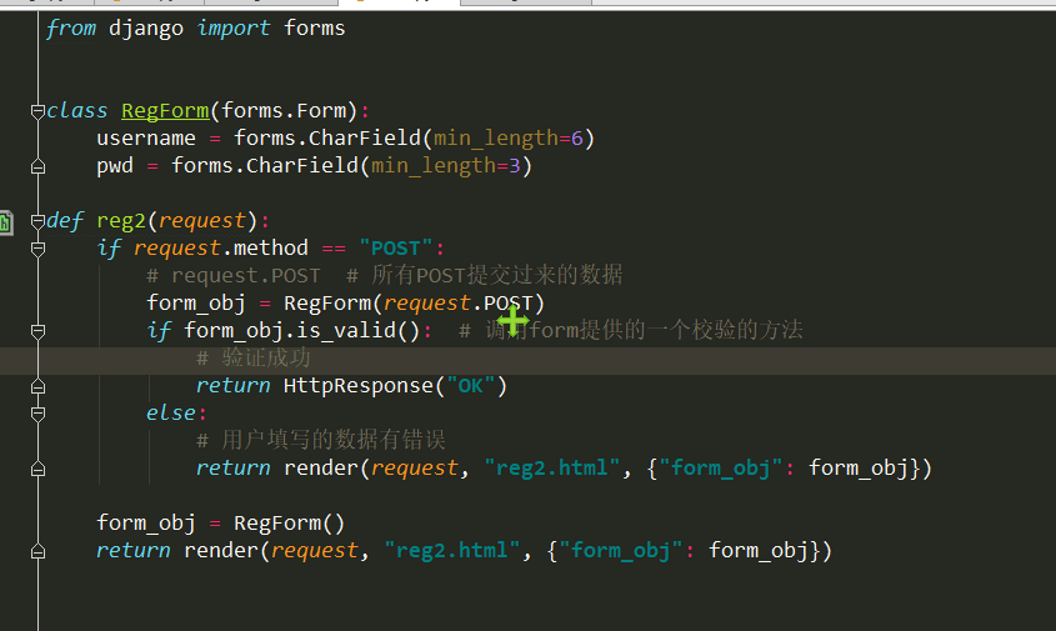
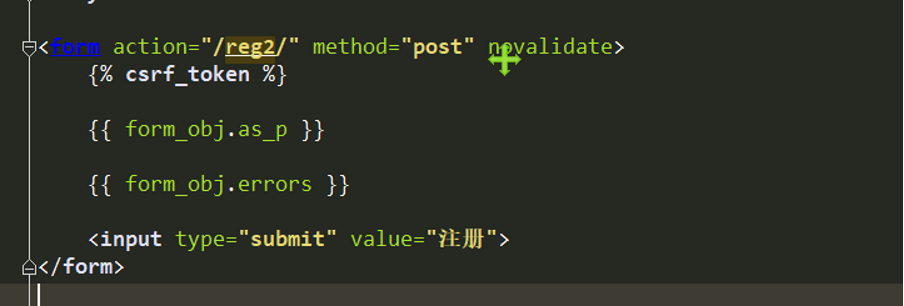
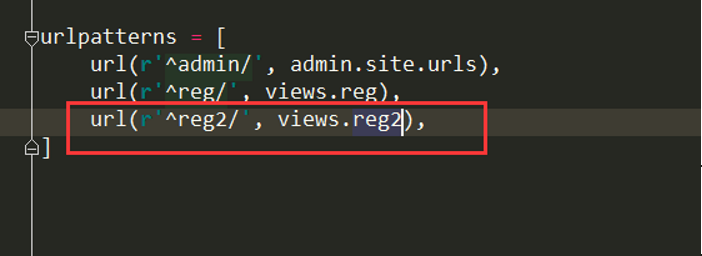
2. form组件的用法
1.自定义一个form类
2. 生成一个form类的实例对象
3. 在前端页面
form_obj.as_p --> 用p标签包裹我每一个字段(提示性的文本、input标签、响应的错误提示信息)
在后端
4. 在后端
form_obj.is_valid(request.POST) --> 对数据做有效性校验
form_obj.cleaned_data --> 获取所有经过校验的数据
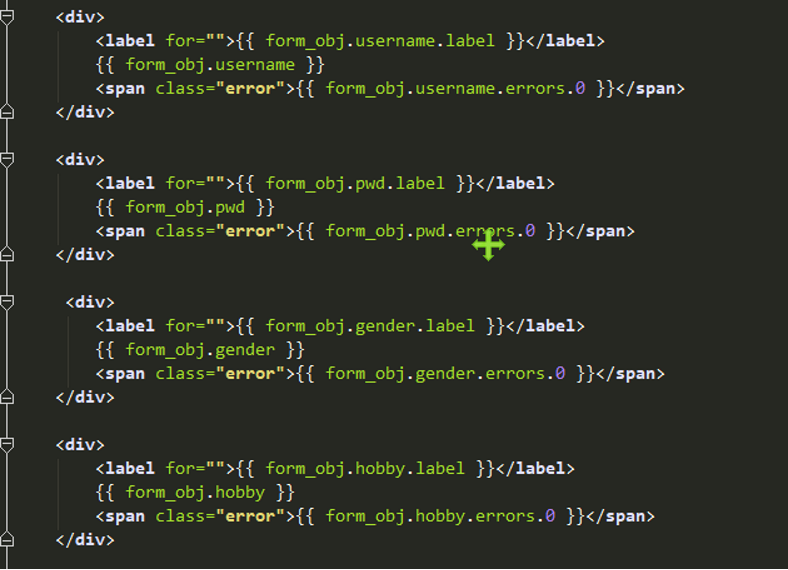
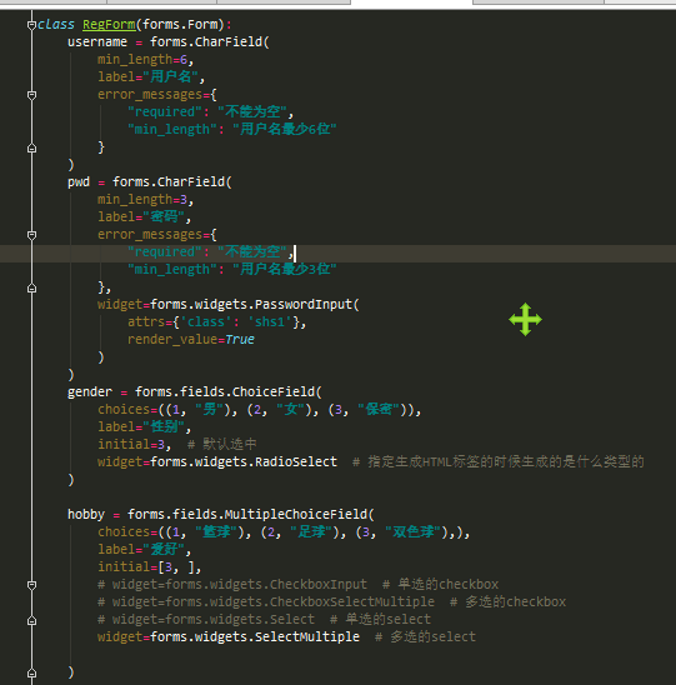
实例:views.py
先定义好一个LoginForm类。

class LoginForm(forms.Form): username = forms.CharField(min_length=8, label="用户名") pwd = forms.CharField(min_length=6, label="密码") def login2(request): error_msg = "" form_obj = LoginForm() if request.method == "POST": form_obj = LoginForm(request.POST) if form_obj.is_valid(): username = form_obj.cleaned_data.get("username") pwd = form_obj.cleaned_data.get("pwd") if username == "Q1mi" and pwd == "123456": return HttpResponse("OK") else: error_msg = "用户名或密码错误" return render(request, "login2.html", {"form_obj": form_obj, "error_msg": error_msg})
login2.html

<!DOCTYPE html> <html lang="en"> <head> <meta charset="UTF-8"> <meta http-equiv="x-ua-compatible" content="IE=edge"> <meta name="viewport" content="width=device-width, initial-scale=1"> <title>login</title> <style> .error { color: red; } </style> </head> <body> <form action="/login2/" method="post" novalidate> {% csrf_token %} <p> {{ form_obj.username.label }} {{ form_obj.username }} <span class="error">{{ form_obj.username.errors.0 }}</span> </p> <p> {{ form_obj.pwd.label }} {{ form_obj.pwd }} <span class="error">{{ form_obj.pwd.errors.0 }}</span> </p> <p> <input type="submit"> <span class="error">{{ error_msg }}</span> </p> </form> </body> </html>
看网页效果发现 也验证了form的功能:
• 前端页面是form类的对象生成的 -->生成HTML标签功能
• 当用户名和密码输入为空或输错之后 页面都会提示 -->用户提交校验功能
• 当用户输错之后 再次输入 上次的内容还保留在input框 -->保留上次输入内容
Form那些事儿
常用字段与插件
创建Form类时,主要涉及到 【字段】 和 【插件】,字段用于对用户请求数据的验证,插件用于自动生成HTML;
initial
初始值,input框里面的初始值。
class LoginForm(forms.Form): username = forms.CharField( min_length=8, label="用户名", initial="张三" # 设置默认值 ) pwd = forms.CharField(min_length=6, label="密码")
error_messages
重写错误信息。
class LoginForm(forms.Form): username = forms.CharField( min_length=8, label="用户名", initial="张三", error_messages={ "required": "不能为空", "invalid": "格式错误", "min_length": "用户名最短8位" } ) pwd = forms.CharField(min_length=6, label="密码")
password
class LoginForm(forms.Form): ... pwd = forms.CharField( min_length=6, label="密码", widget=forms.widgets.PasswordInput(attrs={'class': 'c1'}, render_value=True) )
radioSelect

单radio值为字符串 class LoginForm(forms.Form): username = forms.CharField( min_length=8, label="用户名", initial="张三", error_messages={ "required": "不能为空", "invalid": "格式错误", "min_length": "用户名最短8位" } ) pwd = forms.CharField(min_length=6, label="密码") gender = forms.fields.ChoiceField( choices=((1, "男"), (2, "女"), (3, "保密")), label="性别", initial=3, widget=forms.widgets.RadioSelect )
单选Select

class LoginForm(forms.Form): ... hobby = forms.fields.ChoiceField( choices=((1, "篮球"), (2, "足球"), (3, "双色球"), ), label="爱好", initial=3, widget=forms.widgets.Select )
多选Select
class LoginForm(forms.Form): ... hobby = forms.fields.MultipleChoiceField( choices=((1, "篮球"), (2, "足球"), (3, "双色球"), ), label="爱好", initial=[1, 3], widget=forms.widgets.SelectMultiple )
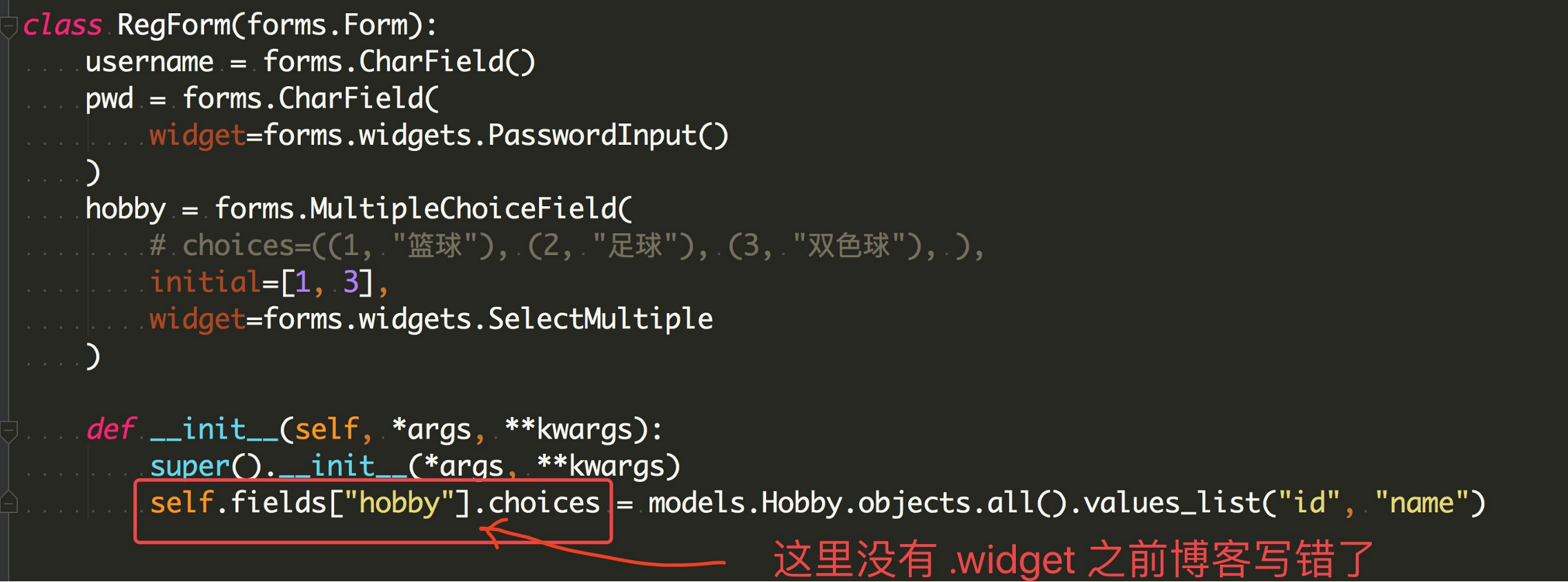
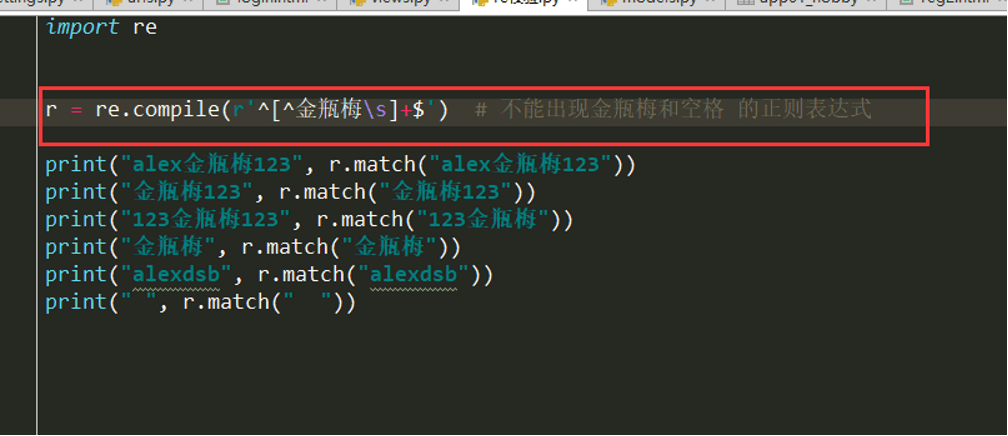
单选checkbox
class LoginForm(forms.Form): ... keep = forms.fields.ChoiceField( label="是否记住密码", initial="checked", widget=forms.widgets.CheckboxInput )
多选checkbox
class LoginForm(forms.Form): ... hobby = forms.fields.MultipleChoiceField( choices=((1, "篮球"), (2, "足球"), (3, "双色球"),), label="爱好", initial=[1, 3], widget=forms.widgets.CheckboxSelectMultiple )
关于choice的注意事项:
在使用选择标签时,需要注意choices的选项可以从数据库中获取,但是由于是静态字段 ***获取的值无法实时更新***,那么需要自定义构造方法从而达到此目的。
方式一:

from django.forms import Form from django.forms import widgets from django.forms import fields class MyForm(Form): user = fields.ChoiceField( # choices=((1, '上海'), (2, '北京'),), initial=2, widget=widgets.Select ) def __init__(self, *args, **kwargs): super(MyForm,self).__init__(*args, **kwargs) # self.fields['user'].widget.choices = ((1, '上海'), (2, '北京'),) # 或 self.fields['user'].widget.choices = models.Classes.objects.all().values_list('id','caption')
方式二:

from django import forms from django.forms import fields from django.forms import models as form_model class FInfo(forms.Form): authors = form_model.ModelMultipleChoiceField(queryset=models.NNewType.objects.all()) # authors = form_model.ModelChoiceField(queryset=models.NNewType.objects.all())
创建Form类时,主要涉及到 【字段】 和 【插件】,字段用于对用户请求数据的验证,插件用于自动生成HTML;
1、Django内置字段如下:

Field required=True, 是否允许为空 widget=None, HTML插件 label=None, 用于生成Label标签或显示内容 initial=None, 初始值 help_text='', 帮助信息(在标签旁边显示) error_messages=None, 错误信息 {'required': '不能为空', 'invalid': '格式错误'} show_hidden_initial=False, 是否在当前插件后面再加一个隐藏的且具有默认值的插件(可用于检验两次输入是否一直) validators=[], 自定义验证规则 localize=False, 是否支持本地化 disabled=False, 是否可以编辑 label_suffix=None Label内容后缀 CharField(Field) max_length=None, 最大长度 min_length=None, 最小长度 strip=True 是否移除用户输入空白 IntegerField(Field) max_value=None, 最大值 min_value=None, 最小值 FloatField(IntegerField) ... DecimalField(IntegerField) max_value=None, 最大值 min_value=None, 最小值 max_digits=None, 总长度 decimal_places=None, 小数位长度 BaseTemporalField(Field) input_formats=None 时间格式化 DateField(BaseTemporalField) 格式:2015-09-01 TimeField(BaseTemporalField) 格式:11:12 DateTimeField(BaseTemporalField)格式:2015-09-01 11:12 DurationField(Field) 时间间隔:%d %H:%M:%S.%f ... RegexField(CharField) regex, 自定制正则表达式 max_length=None, 最大长度 min_length=None, 最小长度 error_message=None, 忽略,错误信息使用 error_messages={'invalid': '...'} EmailField(CharField) ... FileField(Field) allow_empty_file=False 是否允许空文件 ImageField(FileField) ... 注:需要PIL模块,pip3 install Pillow 以上两个字典使用时,需要注意两点: - form表单中 enctype="multipart/form-data" - view函数中 obj = MyForm(request.POST, request.FILES) URLField(Field) ... BooleanField(Field) ... NullBooleanField(BooleanField) ... ChoiceField(Field) ... choices=(), 选项,如:choices = ((0,'上海'),(1,'北京'),) required=True, 是否必填 widget=None, 插件,默认select插件 label=None, Label内容 initial=None, 初始值 help_text='', 帮助提示 ModelChoiceField(ChoiceField) ... django.forms.models.ModelChoiceField queryset, # 查询数据库中的数据 empty_label="---------", # 默认空显示内容 to_field_name=None, # HTML中value的值对应的字段 limit_choices_to=None # ModelForm中对queryset二次筛选 ModelMultipleChoiceField(ModelChoiceField) ... django.forms.models.ModelMultipleChoiceField TypedChoiceField(ChoiceField) coerce = lambda val: val 对选中的值进行一次转换 empty_value= '' 空值的默认值 MultipleChoiceField(ChoiceField) ... TypedMultipleChoiceField(MultipleChoiceField) coerce = lambda val: val 对选中的每一个值进行一次转换 empty_value= '' 空值的默认值 ComboField(Field) fields=() 使用多个验证,如下:即验证最大长度20,又验证邮箱格式 fields.ComboField(fields=[fields.CharField(max_length=20), fields.EmailField(),]) MultiValueField(Field) PS: 抽象类,子类中可以实现聚合多个字典去匹配一个值,要配合MultiWidget使用 SplitDateTimeField(MultiValueField) input_date_formats=None, 格式列表:['%Y--%m--%d', '%m%d/%Y', '%m/%d/%y'] input_time_formats=None 格式列表:['%H:%M:%S', '%H:%M:%S.%f', '%H:%M'] FilePathField(ChoiceField) 文件选项,目录下文件显示在页面中 path, 文件夹路径 match=None, 正则匹配 recursive=False, 递归下面的文件夹 allow_files=True, 允许文件 allow_folders=False, 允许文件夹 required=True, widget=None, label=None, initial=None, help_text='' GenericIPAddressField protocol='both', both,ipv4,ipv6支持的IP格式 unpack_ipv4=False 解析ipv4地址,如果是::ffff:192.0.2.1时候,可解析为192.0.2.1, PS:protocol必须为both才能启用 SlugField(CharField) 数字,字母,下划线,减号(连字符) ... UUIDField(CharField) uuid类型
2、Django内置插件如下:

TextInput(Input)
NumberInput(TextInput)
EmailInput(TextInput)
URLInput(TextInput)
PasswordInput(TextInput)
HiddenInput(TextInput)
Textarea(Widget)
DateInput(DateTimeBaseInput)
DateTimeInput(DateTimeBaseInput)
TimeInput(DateTimeBaseInput)
CheckboxInput
Select
NullBooleanSelect
SelectMultiple
RadioSelect
CheckboxSelectMultiple
FileInput
ClearableFileInput
MultipleHiddenInput
SplitDateTimeWidget
SplitHiddenDateTimeWidget
SelectDateWidget
3、常用选择插件

# 单radio,值为字符串 # user = fields.CharField( # initial=2, # widget=widgets.RadioSelect(choices=((1,'上海'),(2,'北京'),)) # ) # 单radio,值为字符串 # user = fields.ChoiceField( # choices=((1, '上海'), (2, '北京'),), # initial=2, # widget=widgets.RadioSelect # ) # 单select,值为字符串 # user = fields.CharField( # initial=2, # widget=widgets.Select(choices=((1,'上海'),(2,'北京'),)) # ) # 单select,值为字符串 # user = fields.ChoiceField( # choices=((1, '上海'), (2, '北京'),), # initial=2, # widget=widgets.Select # ) # 多选select,值为列表 # user = fields.MultipleChoiceField( # choices=((1,'上海'),(2,'北京'),), # initial=[1,], # widget=widgets.SelectMultiple # ) # 单checkbox # user = fields.CharField( # widget=widgets.CheckboxInput() # ) # 多选checkbox,值为列表 # user = fields.MultipleChoiceField( # initial=[2, ], # choices=((1, '上海'), (2, '北京'),), # widget=widgets.CheckboxSelectMultiple # )
4, 自定义校验的方式
1. 正则
2. 自己写函数,注册到validations
3. 钩子函数
self.errors ---> self._errors = {} --> 用来存放错误信息
self.cleaned_data = {} --> 用来存放通过校验的数据
1. 局部钩子
2. 全局钩子
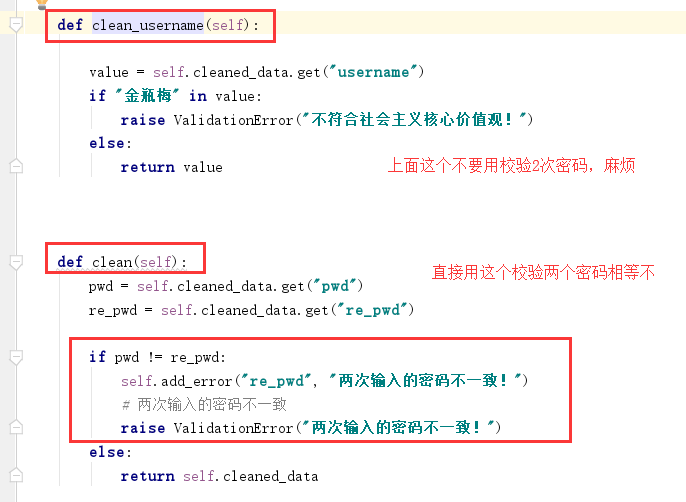
校验
方式一:

from django.forms import Form from django.forms import widgets from django.forms import fields from django.core.validators import RegexValidator class MyForm(Form): user = fields.CharField( validators=[RegexValidator(r'^[0-9]+$', '请输入数字'), RegexValidator(r'^159[0-9]+$', '数字必须以159开头')], )
方式二:

import re from django.forms import Form from django.forms import widgets from django.forms import fields from django.core.exceptions import ValidationError # 自定义验证规则 def mobile_validate(value): mobile_re = re.compile(r'^(13[0-9]|15[012356789]|17[678]|18[0-9]|14[57])[0-9]{8}$') if not mobile_re.match(value): raise ValidationError('手机号码格式错误') class PublishForm(Form): title = fields.CharField(max_length=20, min_length=5, error_messages={'required': '标题不能为空', 'min_length': '标题最少为5个字符', 'max_length': '标题最多为20个字符'}, widget=widgets.TextInput(attrs={'class': "form-control", 'placeholder': '标题5-20个字符'})) # 使用自定义验证规则 phone = fields.CharField(validators=[mobile_validate, ], error_messages={'required': '手机不能为空'}, widget=widgets.TextInput(attrs={'class': "form-control", 'placeholder': u'手机号码'})) email = fields.EmailField(required=False, error_messages={'required': u'邮箱不能为空','invalid': u'邮箱格式错误'}, widget=widgets.TextInput(attrs={'class': "form-control", 'placeholder': u'邮箱'}))
补充进阶
应用Bootstrap样式

<!DOCTYPE html> <html lang="en"> <head> <meta charset="UTF-8"> <meta http-equiv="x-ua-compatible" content="IE=edge"> <meta name="viewport" content="width=device-width, initial-scale=1"> <link rel="stylesheet" href="/static/bootstrap/css/bootstrap.min.css"> <title>login</title> </head> <body> <div class="container"> <div class="row"> <form action="/login2/" method="post" novalidate class="form-horizontal"> {% csrf_token %} <div class="form-group"> <label for="{{ form_obj.username.id_for_label }}" class="col-md-2 control-label">{{ form_obj.username.label }}</label> <div class="col-md-10"> {{ form_obj.username }} <span class="help-block">{{ form_obj.username.errors.0 }}</span> </div> </div> <div class="form-group"> <label for="{{ form_obj.pwd.id_for_label }}" class="col-md-2 control-label">{{ form_obj.pwd.label }}</label> <div class="col-md-10"> {{ form_obj.pwd }} <span class="help-block">{{ form_obj.pwd.errors.0 }}</span> </div> </div> <div class="form-group"> <label class="col-md-2 control-label">{{ form_obj.gender.label }}</label> <div class="col-md-10"> <div class="radio"> {% for radio in form_obj.gender %} <label for="{{ radio.id_for_label }}"> {{ radio.tag }}{{ radio.choice_label }} </label> {% endfor %} </div> </div> </div> <div class="form-group"> <div class="col-md-offset-2 col-md-10"> <button type="submit" class="btn btn-default">注册</button> </div> </div> </form> </div> </div> <script src="/static/jquery-3.2.1.min.js"></script> <script src="/static/bootstrap/js/bootstrap.min.js"></script> </body> </html>
批量添加样式
可通过重写form类的init方法来实现。

class LoginForm(forms.Form): username = forms.CharField( min_length=8, label="用户名", initial="张三", error_messages={ "required": "不能为空", "invalid": "格式错误", "min_length": "用户名最短8位" } ... def __init__(self, *args, **kwargs): super(LoginForm, self).__init__(*args, **kwargs) for field in iter(self.fields): self.fields[field].widget.attrs.update({ 'class': 'form-control' })





【推荐】编程新体验,更懂你的AI,立即体验豆包MarsCode编程助手
【推荐】凌霞软件回馈社区,博客园 & 1Panel & Halo 联合会员上线
【推荐】抖音旗下AI助手豆包,你的智能百科全书,全免费不限次数
【推荐】轻量又高性能的 SSH 工具 IShell:AI 加持,快人一步